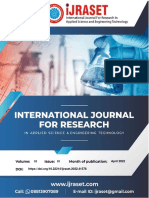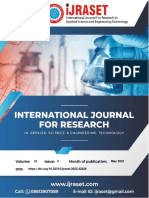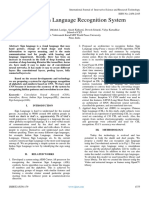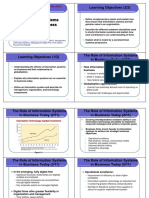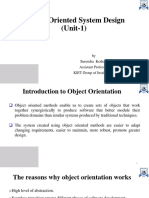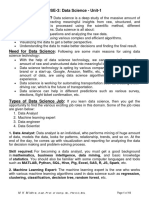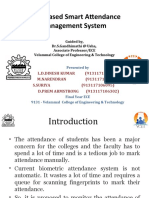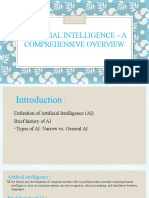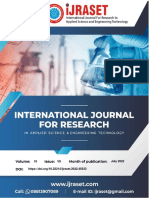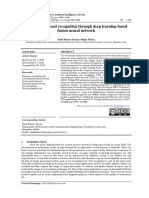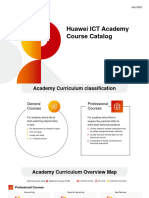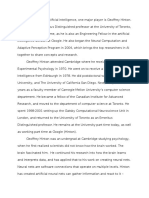Professional Documents
Culture Documents
Sign Language Recognition System
Copyright
Available Formats
Share this document
Did you find this document useful?
Is this content inappropriate?
Report this DocumentCopyright:
Available Formats
Sign Language Recognition System
Copyright:
Available Formats
Volume 7, Issue 7, July – 2022 International Journal of Innovative Science and Research Technology
ISSN No:-2456-2165
Sign Language Recognition System
Likhitha K#, Sahana H J*,Niharika B R, Abhishek Raju# , Prathima M G#
#
Computer Science Department, B.I.T. Bangalore
Abstract:- The goal of vision-based sign language final sign labels. Our model's output demonstrates consistent
recognition is to improve communication for the hearing performance gains for the suggested methodology across all
impaired. However, the majority of the available sign tested datasets. In order to promote two-way communication
language datasets are constrained. Real-time hand sign between the hearing impaired and the general public, we
language identification is a problem in the world of propose a deep learning based architecture for effective
computer vision due to factors including hand occlusion, continuous sign language recognition. We do continuous sign
rapid hand movement, and complicated backgrounds. identification of vast sign vocabularies using real-time input
from a webcam on a phone, laptop, or other device. The
In this study, we develop a deep learning-based input's first SSD architecture is utilised to detect the user's
architecture for effective sign language recognition using hands. Additionally, a 3D hand skeleton is created utilising
Single Shot Detector (SSD), 2D Convolutional Neural the 3D keypoints to provide numerous views of the hand.
Network (2DCNN), 3D Convolutional Neural Network Then, five 3DCNNs are fed with hands,RGB Video , and a
(3DCNN), and Long Short-Term Memory (LSTM) from Depth Video. Each 3DCNN extracts spatio-temporal
Depth and RGB input films. complementary information, such as features related to
appearance, geometry under various camera angles, and
Keywords:- Sign Language Recognition System, Multi Modal features from hand joint prediction scores. For the final
Approach, Skeleton Based. categorization of the hand, the outputs of the five 3DCNNs
are concatenated, ensembled and sent to an LSTM. Finally,
I. INTRODUCTION we can use the expansion of 3D local spatiotemporal features
for long-term sign modelling.
Since sign languages have distinctive linguistic patterns,
they are largely employed as a means of communication by II. LITERATURE REVIEW
the deaf community. A loss of socialisation may occur when
deaf-mute people are unable to communicate with members Sign language recognition system (SLR) has achieved
of the hearing community. The caregiver must communicate great progress and high recognition accuracy in recent years
with the deaf-mute person in these circumstances. Therefore, by developing a practical deep learning architecture and
it is crucial to create a continuous sign language recognition improving computing power [1, 2, 3, 4, 5, 6, 7, 8, 9]. The
system that does not require any apparatus on the hands in remaining task of SLR is to capture all the body movement
order to give these two populations of individuals similar information and local arm,hand,facial expressions at the same
communication opportunities. time. [1] proposes to use a linear discriminant analysis (LDA)
algorithm for hand gesture recognition to convert the
An extensive amount of study has been done to improve recognized hand gestures into text and speech formats. This
the understanding of hand sign language. However, there are paper [2] proposes a hand gesture recognition method based
still a number of difficulties, including real-time performance, on YCbCr color space, COG, and template matching. In [3],
hand occlusion, quick hand movements, and many others. the proposed system utilizes LMC as a sensor and SVM and
DNN is utilized for data training. Study [4] is creating a
Several suggested models combine characteristics in network that can effectively classify images of static signs by
various ways. We are expanding on the 2D hand skeleton equivalent text from CNN. They present a glove system that
model, allowing different view points to learn the features of recognizes numbers from [5] sign language. The KNN
the hand and leveraging the dynamics as a local spatio- algorithm is used as a classifier. Model [6] recognizes
temporal as well as long-term features from the LSTM model. characters using SVM and FMG algorithms. In [7],RNN is
While just the features relating to 2D views of the hand have used to capture the long-term time dependence between the
been included in these models. Our model makes use of inputs and 2D-CNN is used to extract spatial features from
several and complimentary sources of data, including the input. The system proposed in [8] converts the cross-
heatmap features, pixel level appearance, and hand skeleton domain knowledge into message tokens to improve the
view. Utilizing 3DCNN and LSTM, we can learn how to take accuracy of the WSLR model. The proposed system [9]
advantage of the preceding 2DCNN model along with the presents a transformer-based learning system for recognizing
other feature representations. This model also contains a continuous sign language and translating it to text , This is
simple identification procedure: SSD to concentrate on the achieved using connectionist temporal classification (CTC).
region of interest, 2D CNN to extract spatial discriminative These methods are not yet effective enough to get complete
features, 3D CNN to extract local spatio-temporal dynamics motion information.
from various feature representations, and LSTM to recognise
IJISRT22JUL728 www.ijisrt.com 1904
Volume 7, Issue 7, July – 2022 International Journal of Innovative Science and Research Technology
ISSN No:-2456-2165
Multi-modal Approach multi modal approach is an Pose - Word-level sign language recognition is the
end to end framework which provides users with a fundamental building block for interpreting sign language
convolution architecture to exploit different features captured sentences. signalling a sign language word requires very
from an image, word composition and the matching relation subtle body movements that make WSLR a particularly
between the two modalities. Different modalities might challenging problem. The human skeletal motion plays a
contain different information related to the hand gesture significant role in conveying what word the person is
which can complement each other and provide us with a signalling. Hence a pose-based model is used to tackle the
distinctive representation of the action. problem of WSLR. Human pose estimation involves
localising key points of human joints from a single image or
The [4] paper proposes a effective method utilizing a video.The 27-node skeleton graph was constructed using a
super vector to fuse different multi view representation pretrained HRNet whole-body pose estimator given by
together MMPose to estimate 133-point whole-body keypoints from
RGB videos. The graph is divided into four streams (joint,
Skeleton Based Action Recognition Skeleton based bone, joint motion and bone motion). As data augmentations,
action recognition is the process of recognizing action using random sampling, mirroring, rotating, scaling, jittering, and
the skeleton data obtained from the image. The skeleton data shifting are used.
is nothing but the information related to the 2D or 3D
coordinates of the human skeletal joints. It can also be used RGB - To facilitate parallel loading and processing, all
along with other modalities to achieve a multi modal frames of RGB videos are extracted and saved as pictures.
representation of the action. Usually we use recurrent neural Based on the important points derived from whole-body
networks to model skeleton data. posture estimation, RGB and optical flow frames are cropped
and scaled to 256 x 256 pixels.
The [10] proposes a Graph based approach to model the
changing patterns of skeleton data using Graph convoluted Optical Flow - The TVL1 technique, which is
network (GCN). This method is also termed as ST-GCN. But implemented with OpenCV and CUDA, is used to obtain
still the skeleton based sign language recognition systems are optical flow features.The output flow maps of x and y
still under explored. The [12] tried to extend STGCN to SLR directions are concatenated in channel dimension.
but was unsuccessful to achieve higher accuracy and used
only 20 sign classes. HHA - stand for horizontal disparity, height above the
ground and angle normal. The HHA representation encodes
III. OUR APPROACH properties of geocentric pose that emphasize complementary
discontinuities in the image (depth, surface normal and height)
SSTCN - Separable Spatial Temporal Convolution because of which it works better than using raw depth images
Network. for learning feature representations with convolutional neural
networks.
This architecture has proposed an SSTCN to further
exploit whole body skeleton features, which can significantly Depth Flow - HHA features the same way as the RGB
improve the accuracy on whole-body key points compared frames in data augmentation. Besides, the exact same
with the traditional 3D convolution. Besides using key point procedure used for RGB to extract optical flow from the
coordinates generated from the whole-body pose network, an depth modality (named depth flow). The depth flow is cleaner
SSTCN model to perceive the sign language from whole- and captures different information compared with the RGB
body features is also proposed.Features of 33 key points from flow
60 frames of each video as the input to our model is extracted ,
which contains 1 landmark on the nose, 2 landmarks on RGB Ensemble - Ensemble is to combine the
shoulders, 4 landmarks on mouth, 2 landmarks on wrists, 2 predictions from multiple neural network models to reduce
landmarks on elbows and 22 landmarks on hands. the variance of predictions and reduce generalisation error.
Here, The skeleton-based technique, which incorporates SL-
Instead of using 3D convolution, the input features are GCN and SSTCN, outperforms RGB + Flow and Depth
processed with a 2D convolution layer separably, which ensemble models.
reduces the parameters and makes it easier to converge.
IJISRT22JUL728 www.ijisrt.com 1905
Volume 7, Issue 7, July – 2022 International Journal of Innovative Science and Research Technology
ISSN No:-2456-2165
Fig 1:- Our Approach to sign Language Recognition System Using a Multi-Modal Ensemble
The ensemble results of RGB All and RGB-D All
demonstrate that the whole-body skeleton based approaches
are able to collaborate with the other modalities and further
improve the final recognition rate.
Multi ensemble model - We use a simple ensemble
method to ensemble all four modalities above. Specifically,
we save the output of the last fully-connected layers of each
modality before the softmax layer.
IV. Ⅳ. RESULT AND ANALYSIS Table 1:- Results of single modalities on AUTSL dataset.
In this section, we present evaluation of our proposed
framework on the AUTSL dataset.
Autsl Dataset –
Is collected for general SLR tasks in Turkish sign
language. Kinect V2 sensor is utilized in the collection
procedure. Specifically, 43 signers with 20 backgrounds are
assigned to perform 226 different sign actions. In general, it
contains 38,336 video clips which is split to training,
validation, and testing subsets. The statistical summary of the Table 2:- Performance our ensemble results evaluated on
balanced dataset, which is used in the challenge, is listed in AUTSL test set.
Table
Evaluation –
Baseline Method – When training our models on the training set, we adopt
Along with the AUTSL benchmark, several deep an early stopping technique based on the validation accuracy
learning based models are proposed. We treat the best model to obtain our best models. Then we test our best models on
benchmarked in [12]. Specifically, the model is mainly the test set and use the hyperparameters tuned on validation
constructed using CNN + LSTM structure, where 2D-CNN set to obtain our ensemble prediction. To further improve our
model are used to extract feature for each video frame and performance, we finetune our best models on the union of
bidirectional LSTMs (BLSTM) are adopted on top of the training and validation set. we stop training when the training
these 2D CNN features to lean their temporal relations. A loss in our finetuning experiment is reduced to the same level
feature pooling model (FPM) [12] is plugged in after the 2D as our best models in the training phase. Our predictions with
and without finetuning are evaluated and reported in Table 2.
CNN model to obtain multi-scale representation of the Our proposed SAM-SLR approach surpasses the baseline
features. methods significantly.
IJISRT22JUL728 www.ijisrt.com 1906
Volume 7, Issue 7, July – 2022 International Journal of Innovative Science and Research Technology
ISSN No:-2456-2165
V. CONCLUSION [11]. Songyao Jiang, Bin Sun , Lichen Wang, Yue Bai,
Kunpeng Li and Yun Fu , "Skeleton Aware Multi-
In this paper, we propose a new deep learning-based modal Sign Language Recognition" , IEEE Xplore ,
pipeline architecture that efficiently realises real-time 2021.
automated sign language recognition by combining SSDs, [12]. Ozge Mercanoglu Sincan and Hacer Yalim Keles.
2DCNNs, 3DCNNs, and LSTMs. The model gave a new AUTSL: A large scale multi-modal turkish sign
hand skeleton feature representation to 3DCNN for richer language dataset and baseline methods. IEEE Access,
features after projecting it onto three surfaces. To obtain the 8:181340–181355, 2020.
trademark features, we also applied pixel-level 3DCNN and [13]. John Bush Idoko. “Deep learning based sign language
heatmap features. The LSTM is given the concatenated translation system” KSII Transaction on internet and
output of all 3DCNNs with stacked inputs in order to information systems (TIIS). 2020.
recognise sign language completely. Additionally, a thorough [14]. M. E. Al-Ahdal and M. T. Nooritawati, “Review in sign
study of the single view and multiview projections of the language recognition systems,” in 2012 IEEE
2DCNN and 3DCNN models is provided. Symposium on Computers Informatics (ISCI), March
2012, pp. 52–57.
REFERENCES [15]. Cao, Z., Hidalgo, G., Simon, T., Wei, S., & Sheikh, Y.
(2017). OpenPose: Realtime multi-person 2D pose
[1]. Himanshu Gupta, Aniruddh Ramjiwal, Jasmin T. Jose , estimation using part affinity fields (pp. 7291–7299).
"Vision Based Approach to Sign Language Las Vegas, United States: CVPR.
Recognition" , IEEE , 2018. [16]. Dadashzadeh, A., and Tavakoli Targhi, A., and
[2]. Mahesh Kumar N B, " Conversion of Sign Language Tahmasbi, M., & Mirmehdi, M. (2018). HGR-Net: A
into Text" , Springer link , 2018. fusion network for hand gesture segmentation and
[3]. Teak-Wei Chong and Boon-Giin Lee , " American Sign recognition.
Language Recognition Using Leap Motion Controller [17]. Elboushaki, A., Hannane, R., Afdel, K., & Koutti, L.
with Machine Learning Approach" , mdpi Journal , (2020). MultiD-CNN: A multi-dimensional feature
2018. learning approach based on deep convolutional
[4]. Lean Karlo S. Tolentino, Ronnie O. Serfa Juan, August networks for gesture recognition in RGB-D image
C. Thio-ac, Maria Abigail B. Pamahoy, Joni Rose R. sequences. Expert Systems with Applications
Forteza, and Xavier Jet O. Garcia , " Static Sign [18]. Ferreira, P. M., Cardoso, J. S., & Rebelo, A. (2019). On
Language Recognition Using Deep Learning" , the role of multimodal learning in the recognition of
International Journal of Machine Learning and sign language. Multimedia Tools and Applications,
Computing, , 2019 78(8), 10035–10056
[5]. Rim Barioul ,Sameh Fakhfakh Ghribi , Houda Ben [19]. Cao, Zh. And Hidalgo, G. and Simon, T. and Wei, Sh.E.
Jmaa Derbel ,and Olfa Kanoun, " Four Sensors Bracelet and Sheikh, Y. (2017). OpenPose: Realtime Multi-
for American Sign Language Recognition based on Person 2D Pose Estimation using Part Affinity Fields.
Wrist Force Myography" , IEEE Xplore , 2020. [20]. Dadashzadeh, A. and Tavakoli Targhi, A. and
[6]. Paul D. Rosero Montalvo, Pamela Gody Trujillo, Tahmasbi, M. and Mirmehdi, M. (2018). HGR-Net: A
Edison Flores Bosemedian, Jorge Carrascal Garcia, Fusion Network for Hand Gesture Segmentation and
Santiago otero potosi, Henry Benitez Pereira, " Sign Recognition.
Language Recognition Based on Intelligent Glove [21]. Preetham, C.; Ramakrishnan, G.; Kumur, S.; Tamse,
Using Machine Learning Techniques" , IEEE ,2020. A.; Krishnapura, H. Hand Talk-Implemented of a
[7]. Dongxu Li , Cristian Rodriguez Opazo, Xin Yu, Gesture Recognition Glove.
Hongdong Li, “Word-level Deep Sign Language [22]. Guo, H. and Wang, G. and Chen, X. and Zhang, C. and
Recognition from Video: A New Large-scale Dataset Qiao, F. and Yang, H. (2017). Region Ensemble
and Methods Comparison “ , Computer vision Network: Improving Convolutional Network for Hand
foundation , IEEE Xplore., 2020. Pose Estimation.
[8]. Dongxu Li, Xin Yu, Chenchen Xu, Lars Petersson, [23]. Wu, J.; Sun, L.; Jafari, R. A Wearable System for
Hongdong Li , " Transferring Cross-domain Knowledge Recognizing American Sign Language in Real-Time
for Video Sign Language Recognition" , IEEE Xplore , Using IMU and Surface EMG Sensors. IEEE , 2016
2020 [24]. Cheok, M.J.; Omar, Z.; Jaward, M.H. A review of hand
[9]. Necati Cihan Camgoz ,̈ Oscar Kollerq, Simon Hadfield gestures and sign language recognition techniques.
and Richard Bowden , " Sign Language Transformers:
Joint End-to-end Sign Language Recognition and
Translation" , IEEE Xplore , 2020.
[10]. Ozge Mercanoglu Sincan, Anil Osman Tur, and Hacer
Yalim Keles. Isolated sign language recognition with
multi-scale features using LSTM. In 2019 27th Signal
Processing and Communications Applications
Conference (SIU), pages 1–4. IEEE, 2019.
IJISRT22JUL728 www.ijisrt.com 1907
You might also like
- AI Concepts Quiz GradedDocument2 pagesAI Concepts Quiz GradedYesmine MakkesNo ratings yet
- Finger Motion Capture For Sign Language InterpretationDocument11 pagesFinger Motion Capture For Sign Language InterpretationIJRASETPublicationsNo ratings yet
- Sign Language Recognition and Converting Into TextDocument8 pagesSign Language Recognition and Converting Into TextIJRASETPublicationsNo ratings yet
- A Survey Paper On Sign Language RecognitionDocument6 pagesA Survey Paper On Sign Language RecognitionIJRASETPublicationsNo ratings yet
- Sign Language Recognition SystemDocument7 pagesSign Language Recognition SystemIJRASETPublicationsNo ratings yet
- Improve The Recognition Accuracy of Sign Language GestureDocument7 pagesImprove The Recognition Accuracy of Sign Language GestureIJRASETPublicationsNo ratings yet
- Gesture Language Translator Using Raspberry PiDocument7 pagesGesture Language Translator Using Raspberry PiIJRASETPublicationsNo ratings yet
- Indian Sign Language Recognition SystemDocument3 pagesIndian Sign Language Recognition SystemInternational Journal of Innovative Science and Research TechnologyNo ratings yet
- Sign Language RecognitionDocument9 pagesSign Language RecognitionIJRASETPublicationsNo ratings yet
- Convolution Neural Networks For Hand Gesture RecognationDocument5 pagesConvolution Neural Networks For Hand Gesture RecognationIAES IJAINo ratings yet
- Introduction To Information Management IDocument10 pagesIntroduction To Information Management IAidan LitargoNo ratings yet
- Chapter 5 ICT - Lesson1 1 PDFDocument21 pagesChapter 5 ICT - Lesson1 1 PDFSean LiamNo ratings yet
- Smart Bag With Theft Prevention and Real Time TrackingDocument3 pagesSmart Bag With Theft Prevention and Real Time TrackingEditor IJTSRDNo ratings yet
- Object Oriented System Design FundamentalsDocument96 pagesObject Oriented System Design FundamentalsSpot ManNo ratings yet
- Multimodal Medical Image Fusion Based On Sugeno's Intuitionistic Fuzzy SetsDocument8 pagesMultimodal Medical Image Fusion Based On Sugeno's Intuitionistic Fuzzy SetstirupalNo ratings yet
- Fake News DetectionDocument28 pagesFake News DetectionRehan MunirNo ratings yet
- Deaf Sign Language Interpreter Using Hand GesturesDocument4 pagesDeaf Sign Language Interpreter Using Hand Gesturesjezan villalonNo ratings yet
- What is Data Science? Key Concepts and ApplicationsDocument10 pagesWhat is Data Science? Key Concepts and ApplicationsPriyaranjan Soren100% (1)
- Mini Project 2A PPT 2.0Document19 pagesMini Project 2A PPT 2.0Soham Shrikant manjrekarNo ratings yet
- Plant Disease Detection Using Leaf ImageDocument5 pagesPlant Disease Detection Using Leaf ImageSAIKRISHNA S SEC 2020No ratings yet
- Survey On Child Safety Wearable Device Using IoT Sensors and Cloud ComputingDocument8 pagesSurvey On Child Safety Wearable Device Using IoT Sensors and Cloud ComputingInternational Journal of Innovative Science and Research TechnologyNo ratings yet
- Intrusion Detection Using The Dempster-Shafer TheoryDocument43 pagesIntrusion Detection Using The Dempster-Shafer TheorySudi MulyonoNo ratings yet
- CH 4Document55 pagesCH 4BERHAN HAILU100% (1)
- DNN-Based Smart Attendance SystemDocument18 pagesDNN-Based Smart Attendance SystemNaren DranNo ratings yet
- Snake Game IntroductionDocument26 pagesSnake Game IntroductionFE-B-247 DIPESH KUMAR YADAVNo ratings yet
- Chapter5-Technologies Enabling Information Insights and DecisionDocument32 pagesChapter5-Technologies Enabling Information Insights and DecisionShrikar BiranthbailNo ratings yet
- Traffic Prediction For Intelligent Transportation System Using Machine LearningDocument16 pagesTraffic Prediction For Intelligent Transportation System Using Machine LearningIJRASETPublicationsNo ratings yet
- Applications of Business AnalyticsDocument10 pagesApplications of Business AnalyticsMansha YadavNo ratings yet
- E-Voting Concept PaperDocument30 pagesE-Voting Concept PaperSaifullah KhanNo ratings yet
- Shivangi Tyagi (NLP Assignments)Document60 pagesShivangi Tyagi (NLP Assignments)shivangi tyagiNo ratings yet
- Cybersecurity Essentials Chapter 4 Quiz Questions AnswersDocument5 pagesCybersecurity Essentials Chapter 4 Quiz Questions Answersheno ahNo ratings yet
- Sign Language To Text and SpeechDocument8 pagesSign Language To Text and SpeechMohammed TahirNo ratings yet
- Cloud Computing OverviewDocument30 pagesCloud Computing OverviewGaurang BasarkarNo ratings yet
- Sign Language Character Recognition Research PaperDocument5 pagesSign Language Character Recognition Research PaperVanilla SugaNo ratings yet
- ENROLMENT-UPDATE Form Child. 5-18 Years - V3Document2 pagesENROLMENT-UPDATE Form Child. 5-18 Years - V3ZwalletNo ratings yet
- An Overview and Study of Security Issues & Challenges in Cloud ComputingDocument6 pagesAn Overview and Study of Security Issues & Challenges in Cloud ComputingRoyal TNo ratings yet
- Capstone Project Updatedv21Document57 pagesCapstone Project Updatedv21SIDNEY MAE LUNASNo ratings yet
- Cybersecurity Role: Laboratory Exercise 1Document2 pagesCybersecurity Role: Laboratory Exercise 1Leigh VillaNo ratings yet
- Informatics Practices: Question Bank Term-II 2021-22Document126 pagesInformatics Practices: Question Bank Term-II 2021-22sameeksha kosariaNo ratings yet
- Department of Labor and Employment: Annex Y Dole Kabuhayan Program Individual Business PlanDocument3 pagesDepartment of Labor and Employment: Annex Y Dole Kabuhayan Program Individual Business PlanPeso TitayNo ratings yet
- Aa PORTABLE ASSISTIVE DEVICE FOR DEAF DUMB AND BLIND USING AIDocument4 pagesAa PORTABLE ASSISTIVE DEVICE FOR DEAF DUMB AND BLIND USING AIMohammed Abdul Razzak100% (2)
- Presentation On Artificial IntelligenceDocument19 pagesPresentation On Artificial IntelligenceJaswanth S vNo ratings yet
- Facial Emotion Recognition Using Convolution Neural Network: AbstractDocument6 pagesFacial Emotion Recognition Using Convolution Neural Network: AbstractKallu kaliaNo ratings yet
- Continuition Chapter 4 Thesis Documentation Chapters 1 4 ContinueDocument57 pagesContinuition Chapter 4 Thesis Documentation Chapters 1 4 ContinueJE TCNo ratings yet
- Paper 9004Document4 pagesPaper 9004IJARSCT JournalNo ratings yet
- IoT Unit I - OverviewDocument27 pagesIoT Unit I - OverviewGsNo ratings yet
- 10 1 1 677 4290Document166 pages10 1 1 677 4290Tran Dang KhoaNo ratings yet
- Activity Tracker Wrist Band For Children Monitoring Using IOTDocument8 pagesActivity Tracker Wrist Band For Children Monitoring Using IOTAnonymous lPvvgiQjRNo ratings yet
- CSC204 - Section B (Structured)Document9 pagesCSC204 - Section B (Structured)adam hakimNo ratings yet
- Applications of Artificial Intelligence in Machine Learning: Review and ProspectDocument11 pagesApplications of Artificial Intelligence in Machine Learning: Review and ProspectSeyidcem KarakasNo ratings yet
- IOT Based Patient Health Monitoring SystemDocument6 pagesIOT Based Patient Health Monitoring SystemIJRASETPublicationsNo ratings yet
- (M) BROCHURE - Data Science Learning PathDocument33 pages(M) BROCHURE - Data Science Learning PathNirupam NishantNo ratings yet
- Chapter 1 Artificial IntelligenceDocument3 pagesChapter 1 Artificial IntelligenceSankariNo ratings yet
- Rain TechnologyDocument20 pagesRain TechnologyRoop KumarNo ratings yet
- DSM050 Data Visualisation Topic1Document36 pagesDSM050 Data Visualisation Topic1LICHEN YUNo ratings yet
- POS Machines SBIDocument52 pagesPOS Machines SBISakshi SinhaNo ratings yet
- Biometric Seminar ReportDocument15 pagesBiometric Seminar ReportAbhishekNo ratings yet
- Text Detection and Recognition Through Deep Learning-Based Fusion Neural NetworkDocument11 pagesText Detection and Recognition Through Deep Learning-Based Fusion Neural NetworkIAES IJAI100% (1)
- Fingerprint and Face Recognition System Using A Feed-Forward Artificial Neural Network ParadigmDocument12 pagesFingerprint and Face Recognition System Using A Feed-Forward Artificial Neural Network ParadigmInternational Journal of Innovative Science and Research TechnologyNo ratings yet
- Palm Vein Technology AbstractDocument13 pagesPalm Vein Technology Abstractmdayyub82% (11)
- "Asl To Text Conversion": Bachelor of TechnologyDocument15 pages"Asl To Text Conversion": Bachelor of TechnologyGurudev YankanchiNo ratings yet
- Comparatively Design and Analyze Elevated Rectangular Water Reservoir with and without Bracing for Different Stagging HeightDocument4 pagesComparatively Design and Analyze Elevated Rectangular Water Reservoir with and without Bracing for Different Stagging HeightInternational Journal of Innovative Science and Research TechnologyNo ratings yet
- Diabetic Retinopathy Stage Detection Using CNN and Inception V3Document9 pagesDiabetic Retinopathy Stage Detection Using CNN and Inception V3International Journal of Innovative Science and Research TechnologyNo ratings yet
- The Utilization of Date Palm (Phoenix dactylifera) Leaf Fiber as a Main Component in Making an Improvised Water FilterDocument11 pagesThe Utilization of Date Palm (Phoenix dactylifera) Leaf Fiber as a Main Component in Making an Improvised Water FilterInternational Journal of Innovative Science and Research TechnologyNo ratings yet
- Advancing Healthcare Predictions: Harnessing Machine Learning for Accurate Health Index PrognosisDocument8 pagesAdvancing Healthcare Predictions: Harnessing Machine Learning for Accurate Health Index PrognosisInternational Journal of Innovative Science and Research TechnologyNo ratings yet
- Dense Wavelength Division Multiplexing (DWDM) in IT Networks: A Leap Beyond Synchronous Digital Hierarchy (SDH)Document2 pagesDense Wavelength Division Multiplexing (DWDM) in IT Networks: A Leap Beyond Synchronous Digital Hierarchy (SDH)International Journal of Innovative Science and Research TechnologyNo ratings yet
- Electro-Optics Properties of Intact Cocoa Beans based on Near Infrared TechnologyDocument7 pagesElectro-Optics Properties of Intact Cocoa Beans based on Near Infrared TechnologyInternational Journal of Innovative Science and Research TechnologyNo ratings yet
- Formulation and Evaluation of Poly Herbal Body ScrubDocument6 pagesFormulation and Evaluation of Poly Herbal Body ScrubInternational Journal of Innovative Science and Research TechnologyNo ratings yet
- Terracing as an Old-Style Scheme of Soil Water Preservation in Djingliya-Mandara Mountains- CameroonDocument14 pagesTerracing as an Old-Style Scheme of Soil Water Preservation in Djingliya-Mandara Mountains- CameroonInternational Journal of Innovative Science and Research TechnologyNo ratings yet
- The Impact of Digital Marketing Dimensions on Customer SatisfactionDocument6 pagesThe Impact of Digital Marketing Dimensions on Customer SatisfactionInternational Journal of Innovative Science and Research TechnologyNo ratings yet
- A Review: Pink Eye Outbreak in IndiaDocument3 pagesA Review: Pink Eye Outbreak in IndiaInternational Journal of Innovative Science and Research TechnologyNo ratings yet
- Auto Encoder Driven Hybrid Pipelines for Image Deblurring using NAFNETDocument6 pagesAuto Encoder Driven Hybrid Pipelines for Image Deblurring using NAFNETInternational Journal of Innovative Science and Research TechnologyNo ratings yet
- Design, Development and Evaluation of Methi-Shikakai Herbal ShampooDocument8 pagesDesign, Development and Evaluation of Methi-Shikakai Herbal ShampooInternational Journal of Innovative Science and Research Technology100% (3)
- A Survey of the Plastic Waste used in Paving BlocksDocument4 pagesA Survey of the Plastic Waste used in Paving BlocksInternational Journal of Innovative Science and Research TechnologyNo ratings yet
- Cyberbullying: Legal and Ethical Implications, Challenges and Opportunities for Policy DevelopmentDocument7 pagesCyberbullying: Legal and Ethical Implications, Challenges and Opportunities for Policy DevelopmentInternational Journal of Innovative Science and Research TechnologyNo ratings yet
- Hepatic Portovenous Gas in a Young MaleDocument2 pagesHepatic Portovenous Gas in a Young MaleInternational Journal of Innovative Science and Research TechnologyNo ratings yet
- Explorning the Role of Machine Learning in Enhancing Cloud SecurityDocument5 pagesExplorning the Role of Machine Learning in Enhancing Cloud SecurityInternational Journal of Innovative Science and Research TechnologyNo ratings yet
- Navigating Digitalization: AHP Insights for SMEs' Strategic TransformationDocument11 pagesNavigating Digitalization: AHP Insights for SMEs' Strategic TransformationInternational Journal of Innovative Science and Research TechnologyNo ratings yet
- Perceived Impact of Active Pedagogy in Medical Students' Learning at the Faculty of Medicine and Pharmacy of CasablancaDocument5 pagesPerceived Impact of Active Pedagogy in Medical Students' Learning at the Faculty of Medicine and Pharmacy of CasablancaInternational Journal of Innovative Science and Research TechnologyNo ratings yet
- Automatic Power Factor ControllerDocument4 pagesAutomatic Power Factor ControllerInternational Journal of Innovative Science and Research TechnologyNo ratings yet
- Mobile Distractions among Adolescents: Impact on Learning in the Aftermath of COVID-19 in IndiaDocument2 pagesMobile Distractions among Adolescents: Impact on Learning in the Aftermath of COVID-19 in IndiaInternational Journal of Innovative Science and Research TechnologyNo ratings yet
- Review of Biomechanics in Footwear Design and Development: An Exploration of Key Concepts and InnovationsDocument5 pagesReview of Biomechanics in Footwear Design and Development: An Exploration of Key Concepts and InnovationsInternational Journal of Innovative Science and Research TechnologyNo ratings yet
- Studying the Situation and Proposing Some Basic Solutions to Improve Psychological Harmony Between Managerial Staff and Students of Medical Universities in Hanoi AreaDocument5 pagesStudying the Situation and Proposing Some Basic Solutions to Improve Psychological Harmony Between Managerial Staff and Students of Medical Universities in Hanoi AreaInternational Journal of Innovative Science and Research TechnologyNo ratings yet
- The Effect of Time Variables as Predictors of Senior Secondary School Students' Mathematical Performance Department of Mathematics Education Freetown PolytechnicDocument7 pagesThe Effect of Time Variables as Predictors of Senior Secondary School Students' Mathematical Performance Department of Mathematics Education Freetown PolytechnicInternational Journal of Innovative Science and Research TechnologyNo ratings yet
- Drug Dosage Control System Using Reinforcement LearningDocument8 pagesDrug Dosage Control System Using Reinforcement LearningInternational Journal of Innovative Science and Research TechnologyNo ratings yet
- Securing Document Exchange with Blockchain Technology: A New Paradigm for Information SharingDocument4 pagesSecuring Document Exchange with Blockchain Technology: A New Paradigm for Information SharingInternational Journal of Innovative Science and Research TechnologyNo ratings yet
- Enhancing the Strength of Concrete by Using Human Hairs as a FiberDocument3 pagesEnhancing the Strength of Concrete by Using Human Hairs as a FiberInternational Journal of Innovative Science and Research TechnologyNo ratings yet
- Formation of New Technology in Automated Highway System in Peripheral HighwayDocument6 pagesFormation of New Technology in Automated Highway System in Peripheral HighwayInternational Journal of Innovative Science and Research TechnologyNo ratings yet
- Supply Chain 5.0: A Comprehensive Literature Review on Implications, Applications and ChallengesDocument11 pagesSupply Chain 5.0: A Comprehensive Literature Review on Implications, Applications and ChallengesInternational Journal of Innovative Science and Research TechnologyNo ratings yet
- Intelligent Engines: Revolutionizing Manufacturing and Supply Chains with AIDocument14 pagesIntelligent Engines: Revolutionizing Manufacturing and Supply Chains with AIInternational Journal of Innovative Science and Research TechnologyNo ratings yet
- The Making of Self-Disposing Contactless Motion-Activated Trash Bin Using Ultrasonic SensorsDocument7 pagesThe Making of Self-Disposing Contactless Motion-Activated Trash Bin Using Ultrasonic SensorsInternational Journal of Innovative Science and Research TechnologyNo ratings yet
- Sentimental Analysis Project DocumentationDocument67 pagesSentimental Analysis Project DocumentationSukanya Vemulapalli67% (3)
- Citrus Disease Detection and Classification Using End-To-End Anchor-Based Deep Learning ModelDocument12 pagesCitrus Disease Detection and Classification Using End-To-End Anchor-Based Deep Learning ModelSaravanan DevarajNo ratings yet
- Convolutional Neural Networks in Python - Master Data Science and Machine Learning With Modern Deep Learning in Python, Theano, and TensorFlow (Machine Learning in Python) (PDFDrive) PDFDocument75 pagesConvolutional Neural Networks in Python - Master Data Science and Machine Learning With Modern Deep Learning in Python, Theano, and TensorFlow (Machine Learning in Python) (PDFDrive) PDFCesar Augusto QuinteroNo ratings yet
- Binary Code Vulnerability Detection Based On Multi-Level Feature FusionDocument12 pagesBinary Code Vulnerability Detection Based On Multi-Level Feature FusionRADHAKRISHNA SASTRY PUDIPEDDINo ratings yet
- 2022 PYTHON PROJECTS LIST (New)Document25 pages2022 PYTHON PROJECTS LIST (New)MUSHAM HARI KIRAN6737No ratings yet
- Assessment of Plant Disease Identification Using GLCM and KNN AlgorithmsDocument5 pagesAssessment of Plant Disease Identification Using GLCM and KNN AlgorithmsLiyana LiyaNo ratings yet
- Fashion Analysis and Understanding With Artificial IntelligenceDocument15 pagesFashion Analysis and Understanding With Artificial Intelligencefefepoj556No ratings yet
- Data Augmentation On Plant Leaf Disease Image Dataset Using Image Manipulation and Deep Learning TechniquesDocument6 pagesData Augmentation On Plant Leaf Disease Image Dataset Using Image Manipulation and Deep Learning Techniqueszoric99No ratings yet
- Abdul Ashu ResumeDocument5 pagesAbdul Ashu ResumejayaraoNo ratings yet
- Unit IvDocument34 pagesUnit Ivdanmanworld443No ratings yet
- Lecture Notes For Chapter 4 Artificial Neural Networks Introduction To Data Mining, 2 EditionDocument22 pagesLecture Notes For Chapter 4 Artificial Neural Networks Introduction To Data Mining, 2 Editionعبد الحافظ عبد الحافظNo ratings yet
- Machine Learning and A I For Risk ManagementDocument18 pagesMachine Learning and A I For Risk ManagementpiermeNo ratings yet
- Fashion Recommendation System Using Machine LearningDocument8 pagesFashion Recommendation System Using Machine LearningMES LibraryNo ratings yet
- 【202307】Huawei ICT Academy Course Catalog-new-2pdf.com-edit-metadata (2)Document27 pages【202307】Huawei ICT Academy Course Catalog-new-2pdf.com-edit-metadata (2)Mimisha SaloNo ratings yet
- Deep Learning in Mental Health Outcome Research: A Scoping ReviewDocument26 pagesDeep Learning in Mental Health Outcome Research: A Scoping ReviewRamKrishna108No ratings yet
- Test - 1 IDSDocument20 pagesTest - 1 IDStristann rachmadiNo ratings yet
- The Impact of Artificial Intelligence in Digital MarketingDocument63 pagesThe Impact of Artificial Intelligence in Digital Marketingammar z100% (1)
- Classification of Multimodal Spam Using Deep LearningDocument45 pagesClassification of Multimodal Spam Using Deep LearningArpan MannaNo ratings yet
- SPPU High Performance ComputingDocument12 pagesSPPU High Performance ComputingGovind RajputNo ratings yet
- Geoffrey HintonDocument3 pagesGeoffrey Hintonapi-349043956No ratings yet
- Distributed Deep Learning For Parallel TrainingDocument7 pagesDistributed Deep Learning For Parallel TrainingSibga saeed AkhtarNo ratings yet
- AI for Business Leaders Executive Program SyllabusDocument12 pagesAI for Business Leaders Executive Program SyllabusLab xNo ratings yet
- Gandhmal 2019Document13 pagesGandhmal 2019Vamshi ThavNo ratings yet
- How New Pedagogies Find Deep LearningDocument99 pagesHow New Pedagogies Find Deep LearningSelene ChinNo ratings yet
- Lecture 1 Introduction by Dr. Fazeel AbidDocument26 pagesLecture 1 Introduction by Dr. Fazeel AbidM. Talha NadeemNo ratings yet
- DL 3Document9 pagesDL 3Thanu ShriNo ratings yet
- Automated Image Capturing System For Deep Learning-Based Tomato Plant Leaf Disease Detection and RecognitionDocument6 pagesAutomated Image Capturing System For Deep Learning-Based Tomato Plant Leaf Disease Detection and RecognitionEdgar AguirreNo ratings yet
- Machine Learning & Deep LearningDocument23 pagesMachine Learning & Deep LearninggalagrandNo ratings yet
- Khalid Salah Amer DsDocument2 pagesKhalid Salah Amer DsAhmed SalamaNo ratings yet



